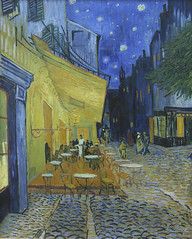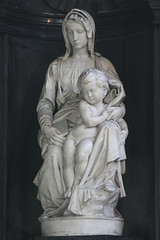The Art of Teaching
Sep 28, 2008
After a splendid summer holiday touring a number of north European cities, with visits to galleries, concert halls and churches, and the opening of our new performing and creative arts building, the arts have been much on my mind. They are set to form something of a focus to our work as a staff over the year ahead. I’m keen though to go beyond merely building on the work done in our music, art, drama and dance lessons; the opportunities afforded by making closer links between the arts and the rest of the curriculum are certainly to be seized, and I’m very excited about some of the ideas we’ve had: symmetry and pattern in maths, role play and other drama in the humanities, use of paintings as source material for history and geography lessons, cool digital arts stuff, etc. It promises to be an exciting year.
More exciting still though is the the notion of looking at our teaching as an art in itself; approaching our work in the classroom in a not dissimilar way to the way in which musicians, artists, actors and dancers approach their work. Three aspects of such an approach immediately come to mind.
Creativity.  I’m eager to re-emphasize the essentially creative process of good teaching. A good lesson has, I think, at least something in common with the notion of a performance, with the uniqueness which that implies. The long tradition of teachers making their own resources in the primary sector is certainly one I’m keen to maintain, and of course digital technology should make it easier to adapt and refine resources from elsewhere – assuming they come with an open, creative commons licence that is. The notion of following lesson plans prepared in advance by the standards unit is, I’m afraid, anathema to me, although there’s something to be said for using these as a starting point or inspiration: the MEP plans being a case in point. Working exclusively, or perhaps even mainly, from a published scheme, textbook or plans is, to my mind at least, hugely de-professionalising. What I’m really looking for though is a willingness to innovate, to push the boundaries, to try teaching things in a different way this time round, perhaps in a way that’s entirely original. This is going to be harder work, I know, but it’s surely much more fun, and keeps the lessons fresh for teacher and student alike.
I’m eager to re-emphasize the essentially creative process of good teaching. A good lesson has, I think, at least something in common with the notion of a performance, with the uniqueness which that implies. The long tradition of teachers making their own resources in the primary sector is certainly one I’m keen to maintain, and of course digital technology should make it easier to adapt and refine resources from elsewhere – assuming they come with an open, creative commons licence that is. The notion of following lesson plans prepared in advance by the standards unit is, I’m afraid, anathema to me, although there’s something to be said for using these as a starting point or inspiration: the MEP plans being a case in point. Working exclusively, or perhaps even mainly, from a published scheme, textbook or plans is, to my mind at least, hugely de-professionalising. What I’m really looking for though is a willingness to innovate, to push the boundaries, to try teaching things in a different way this time round, perhaps in a way that’s entirely original. This is going to be harder work, I know, but it’s surely much more fun, and keeps the lessons fresh for teacher and student alike.
One can go further still, opening up the creativity to include the what as well as the how one teaches. I fear national curricula and exam specifications make this difficult, but surely not impossible, as these documents are minimal rather than maximal. I have fond memories of going way off syllabus to do stuff like Victorian mathematics (£.s.d, log tables etc) and cryptography back in my teaching days, creating resources from scratch myself, and providing a far richer mathematical diet for my pupils in the process.
Individuality.  Not, of course, unrelated to the above, but I think if we are to see teaching as an art, then we have to allow a place for the individuality of the teacher – I think here about personalised teaching to sit alongside the personalised learning on which the DCFS places its emphasis. The system of bringing a near random group of children of similar age and postcode together with a single adult places a heavy responsibility on that adult: there’s far more to education than the skills, understanding and knowledge that we list in our curricula; the process of the formation of character is something that happens by example rather than instruction. I suspect that if most of us think back to the great teachers we had in our youth, then they will be the ones who brought something of themselves into the classroom; obviously a certain professional distance is expected, but we can contribute much to the all-round education of our pupils through sharing something of our all-round enthusiasms, rather than merely our subject expertise: something which extra-curricular activities, residential programmes, sports coaching and the house system perhaps still preserve. Given the choice, I think one looks for gifted eccentrics rather than team players – staff as jazz band rather than symphony orchestra, hard as that may be to manage.
Not, of course, unrelated to the above, but I think if we are to see teaching as an art, then we have to allow a place for the individuality of the teacher – I think here about personalised teaching to sit alongside the personalised learning on which the DCFS places its emphasis. The system of bringing a near random group of children of similar age and postcode together with a single adult places a heavy responsibility on that adult: there’s far more to education than the skills, understanding and knowledge that we list in our curricula; the process of the formation of character is something that happens by example rather than instruction. I suspect that if most of us think back to the great teachers we had in our youth, then they will be the ones who brought something of themselves into the classroom; obviously a certain professional distance is expected, but we can contribute much to the all-round education of our pupils through sharing something of our all-round enthusiasms, rather than merely our subject expertise: something which extra-curricular activities, residential programmes, sports coaching and the house system perhaps still preserve. Given the choice, I think one looks for gifted eccentrics rather than team players – staff as jazz band rather than symphony orchestra, hard as that may be to manage.
The pursuit of excellence.  I’m a great fan of opera: this summer was the first since moving down here that we didn’t make it to Gyndebourne, but I remember reading that John Christie, who founded the thing, had this vision of a company that was relentless in the pursuit of perfection – something that remains a fond memory too of the choral singing back in my choir school days. I’m certain that this is something which there should be in artistic teaching too. I guess the notion of reflective practice comes close to this, as does our own school motto, “Be the best you can be”. The pursuit of excellence is difficult though, because one so rarely has the time to do things perfectly – the time pressures and variety of commitments are the things that get in the way of truly artistic teaching; unlike the archetypal artist we just don’t have the time to make every lesson a perfect one; that said, we do have the chance to edit, to review, to revise, to iterate towards that ideal, if not this year then for next: important as good planning is, its the critical evaluation of the lesson which allows the improvements to be made. I know that excellence such as that which characterizes great art is a high standard for this line of work, but perhaps for most of us it isn’t the excellence that matters in the end, but the eagerness to aim for it. But then again, why settle for second best?
I’m a great fan of opera: this summer was the first since moving down here that we didn’t make it to Gyndebourne, but I remember reading that John Christie, who founded the thing, had this vision of a company that was relentless in the pursuit of perfection – something that remains a fond memory too of the choral singing back in my choir school days. I’m certain that this is something which there should be in artistic teaching too. I guess the notion of reflective practice comes close to this, as does our own school motto, “Be the best you can be”. The pursuit of excellence is difficult though, because one so rarely has the time to do things perfectly – the time pressures and variety of commitments are the things that get in the way of truly artistic teaching; unlike the archetypal artist we just don’t have the time to make every lesson a perfect one; that said, we do have the chance to edit, to review, to revise, to iterate towards that ideal, if not this year then for next: important as good planning is, its the critical evaluation of the lesson which allows the improvements to be made. I know that excellence such as that which characterizes great art is a high standard for this line of work, but perhaps for most of us it isn’t the excellence that matters in the end, but the eagerness to aim for it. But then again, why settle for second best?
The other side of this is equally exciting – the way that artistic teaching, reflecting these qualities, leads to artistic learning, with just the same emphasis on creativity, individuality and the pursuit of excellence.
Share